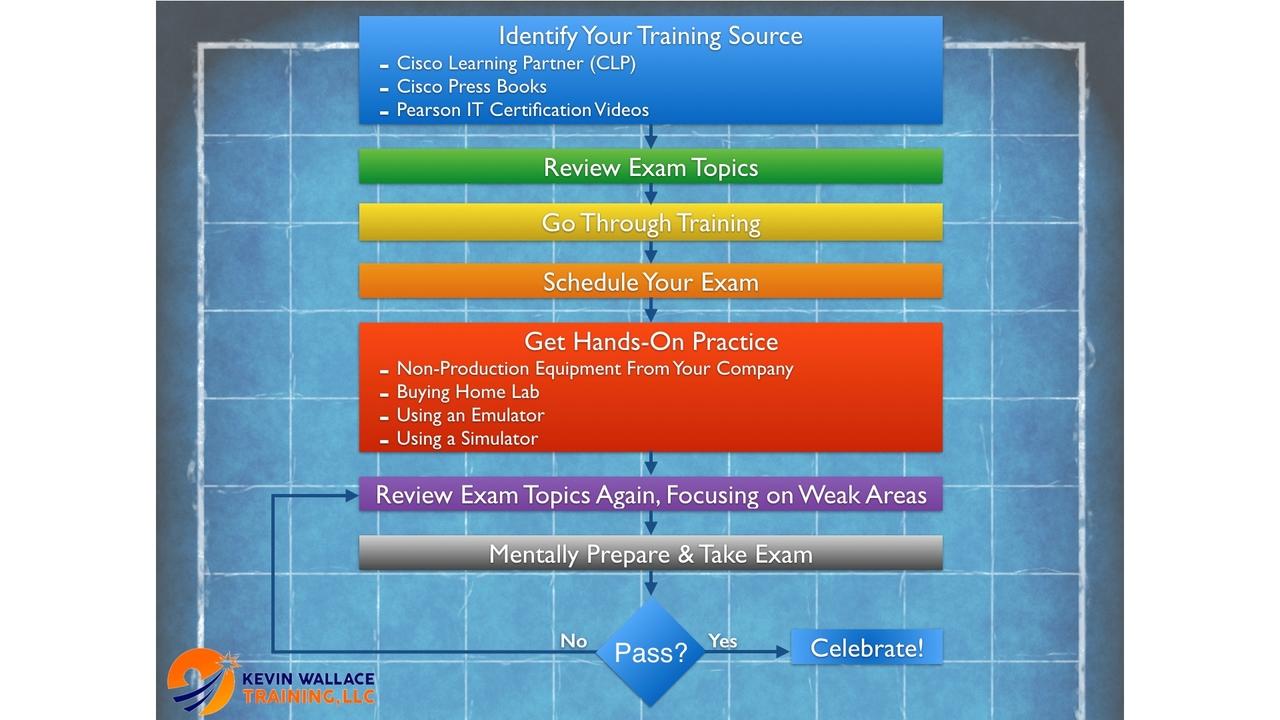Your Framework for Cisco Exam Preparation
Sep 20, 2016
You want to get your first (or next) Cisco certification, but do you have a specific preparation strategy, or are you just winging it? If you do have a structured framework you’re confidently executing against, congratulations! If not, allow me to share my seven-step framework for Cisco exam preparation.

Step #1: Identify Your Training Source
When it comes to learning what you need to learn, the good news is, you’ve got options. Let’s compare a few:
Cisco Learning Partner
The traditional approach, and the way I trained certification candidates for nearly fourteen years, is to take an official Cisco course from a Cisco Learning Partner (CLP). You might have the option of taking your course at a training facility or on-line, and you typically get access to the gear you need to perform lab tasks during the course. You also get Cisco’s official course material. However, a gotcha that many people don’t realize is that Cisco typically has different groups preparing the official course material and creating the exams. So, it’s a fairly common occurrence for Cisco to publish a list of exam topics, and then find some of those topics not covered in the official curriculum. The good news is, in many cases, the Certified Cisco Systems Instructor (CCSI) leading the course knows this, and they’ll add content to fill in the gaps.
Cisco Press Books
Cisco Press is a division of the Pearson publishing house, and for the past 20 years, they’ve been the only Cisco-authorized publisher of exam preparation materials. When a Cisco Press author is writing a book, they have access to the official curriculum as it’s in development. Also, they get access to the list of exam topics. So, Cisco Press books have the benefit of being early to market after a new exam comes out, along with the benefit of being comprehensive. So, I think self-studying with Cisco Press books is a great option.
Pearson IT Certification Videos
Even though they lack the Cisco Press moniker, you can go to Cisco Press’ website and purchase video training series published by Pearson IT Certification. The two main categories of these video training series are:
LiveLessons
The LiveLessons products typically cover a subset of topics on a particular exam. I think of these videos as “lab replacements.” For example, let’s say that you were self-studying for your CCNA Collaboration certification. You could purchase the corresponding Cisco Press books. Then, for your lab solution, you could purchase the CCNA Collaboration LiveLessons video training series.
Complete Video Courses
As the name suggests, the Complete Video Courses are based on Cisco’s list of exam topics, and they cover everything you need in order to prepare for your exam. For example, let’s say you’re more of a visual learner, and you want to prepare for the new CCNA R/S version 3 exam. You could purchase my CCNA R/S version 3 Complete Video Course. That course (which contains over 25 hours of instruction, 300+ videos, interactive exercises, quizzes, and practice exams) teaches you everything you need to know to successfully earn your CCNA R/S.
Step #2: Review Exam Topics
Before diving head first into your chosen training source, I recommend you review Cisco’s published list of exam topics. By first seeing what you’re going to be learning, your brain’s Reticular Activating System (RAS) will better resonate with each topic as you come across it in your study. As an example, here’s a shortcut link I created to get you to Cisco’s list of exam topics for the CCNA R/S version 3 exam: http://kwtrain.com/ccnatopics
Step #3: Go Through Your Training
Now that you know how you’re going to be studying and what you’re going to be learning, it’s time to actually do the work of study. This is were many certification candidates get derailed. It’s so easy to get caught up in other things if you don’t carve out dedicated study time in your schedule.
For example, you might commit to eight hours of study per week. However, that’s not specific enough. You should say exactly when during a week you’ll be studying. Maybe you’ll get up one hour early on each weekday and dedicate three hours each Saturday to study. That’s your eight hours per week.
Step #4: Schedule Your Exam
After you’re a few weeks into your study, you should be able to gauge when you’ll be ready to take the exam. Let’s say that you estimate you’ll be ready to take your exam on December 1st. If that’s case, then my recommendation is to register for that exam on November 1st, one month prior to your exam date. You get a couple of benefits by scheduling a month in advance. First, you have a better selection of times at your preferred testing location, and second, having driven that stake in the ground, you’ll be more motivated to complete your studies by that date.
Step #5: Get Hands-On Practice
In addition to memorizing facts, hands-on experience is critical for many certification candidates. However, some certifications lend themselves to hands-on practice more than others. For example, if you’re going after your CCNA Collaboration certification, getting access to Cisco Unified Communications Manager (CUCM) servers and Cisco IP Phones with video support can be more challenging that getting access to the routers and switches needed by a CCNA R/S candidate. That’s were Pearson IT Certification’s LiveLessons products can really help out.
However, staying with our example of CCNA R/S exam preparation, you’ve got several options to get hands-on experience. Here are some of my favorites:
- Using non-production equipment at your company (with their permission)
- Buying a home lab
- Using an emulator
- Cisco Learning Labs
- Cisco Virtual Internet Routing Lab (VIRL)
- Using a simulator
Step #6: Review Exam Topics Again, While Identifying Any Weak Areas
Even though you’ve done the heavy lifting of studying at this point in the framework, you’re probably not a master of every topic yet. In fact, there might be some areas where it’s glaringly obvious that you’re weak. Well, now is the time to identify and address those areas before showing up for the exam. The recommendation I have for you is to read through the exam topics again, and candidly evaluate your level of proficiency on each topic. When you’re done, you’ll have a list of topics that you can now revisit in your study materials.
Step #7: Mentally Prepare Yourself, and Take the Exam
It’s exam day! The evidence of all your hard work is about to show up. But before stepping into the exam environment, you want to be at your best. Here are a few tips to help you approach the exam with confidence and competence:
- Increase Your Confidence With Incantations: I learned to power of incantations from Tony Robbins. Please note that an incantation is not an affirmation, where in an emotionless state you repeat the same mantra over and over. No, and incantation is said with great emotion, and it’s enhanced if you make powerful gestures as you’re saying these incantations. Tony says that, “Emotion is created by motion.” Here’s an incantation I used to repeatedly scream out loud in my car, “I overwhelm my challenges with preparation.” That incarnation reminded me that I was more than enough prepared for what I was about to face, and if you’ll do this for about a minute with full out intensity, you’ll be vibrating at the end.
- Reduce Stress By Arriving Early: Unless you have a line-of-sight view of the testing center from your location, you need to anticipate possible traffic delays. You don’t want to be stressed out by arriving at the testing center late or barely on time. What I do is leave about 20 minutes earlier than I would have to leave. Then, when I arrive at the testing center early, I don’t pour over my notes (that would just add stress). Instead, I spend a few minutes in my car taking deep breaths and calming myself down.
- Decrease Nervousness By Striking a Pose: In Amy Cuddy’s book Presence, she teaches you to stand like “Wonder Woman” (good posture, hands on hips, confident expression on your face). By doing this for just two minutes, your body increases its production of Testosterone (making you feel more confident) and decreases its production of Cortisol (making you feel less nervous). Although I prefer to think of my self standing more like Superman than Wonder Woman, this is definitely a practice I use. In fact, before I took my last Cisco exam, I went into a restroom stall and for two minutes did my “power pose.”
By using these three simple hacks, you can begin your exam with more confidence, less stress, and less nervousness.
Aftermath
After the exam is over, what you do next greatly depends on whether you passed or not. If you did, it’s time to celebrate! Share the news with your friends, family, and coworkers. Post it on social media, and let people celebrate your success with you.
If your exam attempt did not result in a passing score, don’t be overly concerned. Depending on which Cisco exam you take, you might find some questions to be somewhat tangential to the official list of topics. You might even find grammatical and technical errors. That was certainly my experience on the last exam I took. In fact, I nearly ran out of time, because I spent so much time entering comments about how different questions should be corrected. While it can certainly seem unfair to fail exam that contained errors, console yourself in the fact that you’re not alone. Others that passed the exam had to deal with the exam flaws. You’ve now seen the exam, and while it’s fresh in your mind, I recommend writing down the questions you found challenging. This will let you go back and research them for your next attempt.
I’ve certainly failed lots of Cisco exams, and I failed three of five CCIE labs. Here’s a metaphor that helps me. When Christopher Columbus sailing the “ocean blue” in 1492, many of the crew were becoming disgruntled that they hadn’t seen land, and they were afraid they were going to die. Then, one day, they saw driftwood in the water. Not land, just driftwood. But, the driftwood indicated they were getting close to land. So, if you feel discouraged after failing a Cisco exam, I encourage you to see that printout of your exam results as “driftwood,” indicating you’re getting close. Just keep going.

Kevin Wallace, CCIEx2 (R/S and Collaboration) #7945
If you enjoyed this article, you might also want to subscribe to my podcast:
iTunes: http://kwtrain.com/podcast


